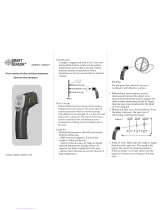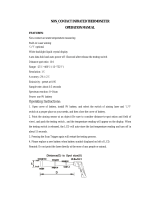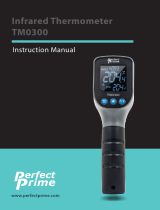Page is loading ...

User Manual
THE STANDARD IN PRECISION MEASUREMENT
Infrared Thermometer
with 12:1 Distance-to-Sight Ratio
and Temperature Alarm
with NIST-Traceable Calibration
Model 20250-05

2
Introduction
The Digi-Sense Infrared Thermometer (Model 20250-05)
with 12 to 1 distance-to-sight ratio and temperature alarm
offers fast response and high accuracy. Advanced features
include temperature alarm, adjustable emissivity, data
Hold, Min/Max readings, and auto power-off. The instru-
ment is fully tested and calibrated to NIST-traceable stan-
dards. Careful use of this meter will provide years of
reliable service.
Unpacking
Check individual parts against the list of items below. If
anything is missing or damaged, please contact your
instrument supplier immediately.
1. Meter
2. One 9 V battery
3. User manual
4. NIST-traceable calibration report with data

3
Key Features
• 12:1 Distance-to-sight ratio
• 1% basic accuracy
• Adjustable emissivity from 0.10 to 1.0
• Rapid detection function
• Precise noncontact measurements
• Laser sighting
• User-selectable °C or °F units
• Automatic data Hold
• MAX/MIN temperature displays
• Automatic selection range and display resolution
• High and low alarms (visual and audible)
• Trigger lock
• Backlight LCD
• Automatic power-off to conserve battery life

4
Meter Description
1. IR sensor
2. Laser pointer beam
3. LCD
4. Down button
5. Up / Laser button
6. MODE button
7. Measurement trigger
8. Battery cover
9. Handle grip
10. Temperature alarm indicator light
3
2
5
6
1
4
7
8
9
10

5
Display Layout
1. Max or Min reading
2. Temperature readout
3. SCAN measuring indicator
4. Data hold icon
5. Laser pointer indicator
6. Trigger lock indicator
7. High alarm indicator
8. Low alarm indicator
9. °C temperature icon
10. °F temperature icon
11. Low-battery indicator
12. Emissivity readout
9
3 4 7 8
2
1
5 6
10
11
12

6
How it Works
Infrared thermometers measure the surface tempera-
ture of an object. The unit’s optics sense emitted,
reflected, and transmitted energy, which is collected
and focused onto a detector. The unit’s electronics
translate the information into a temperature reading
which is displayed on the unit. The laser is used for
aiming purposes only.
Field of View
Make sure that the target is larger than the unit’s spot
size. The smaller the target, the closer you should be
to it. When accuracy is critical, make sure the target
is at least twice as large as the spot size.
Distance and Spot Size
As the distance (D) from the object increases, the
spot size (S) of the area measured by the unit
becomes larger.
Locating a Hot Spot
To find a hot spot, aim the thermometer outside the
area of interest, then scan across with an up-and-
down motion until you locate hot spot.

7
Emissivity
Emissivity is a term used to describe the energy-
emitting characteristics of materials. Most (90% of
typical applications) organic materials and painted
or oxidized surfaces have an emissivity of 0.95
(preset in the unit). Inaccurate readings will result
from measuring shiny or polished metal surfaces.
To compensate, cover the surface to be measured
with black tape or flat black paint. Allow time for the
tape to reach the same temperature as the material
underneath it. Measure the temperature of the tape
or painted surface. (Refer to table on page 8.)
Good Measuring Practices
Holding the meter by its handle, point the IR sensor
toward the object whose temperature is to be mea-
sured. The meter automatically compensates for
temperature deviations from ambient temperature.
Keep in mind that it will take up to 30 minutes for
the IR sensor to stabilize if going from ambient tem-
peratures to a much higher (or lower) temperature
measurement.
Reminders
• The unit is not recommended for measuring shiny
or polished metal surfaces (stainless steel,
aluminum, etc.). See Emissivity above.
• The unit cannot measure through transparent
surfaces such as glass. It will measure the surface
temperature of the glass instead.
• Steam, dust, smoke, etc. can prevent accurate
measurement by obstructing the unit’s optics.

8
Emissivity Values
Substance
Thermal
emissivity
Substance
Thermal
emissivity
Asphalt 0.90 to 0.98 Cloth (black) 0.98
Concrete 0.94 Human skin 0.98
Cement 0.96 Lather 0.75 to 0.80
Sand 0.90 Charcoal (powder) 0.96
Earth 0.92 to 0.96 Lacquer 0.80 to 0.95
Water 0.92 to 0.96 Lacquer (matte) 0.97
Ice 0.96 to 0.98 Rubber (black) 0.94
Snow 0.83 Plastic 0.85 to 0.95
Glass 0.90 to 0.95 Timber 0.90
Ceramic 0.90 to 0.94 Paper 0.70 to 0.94
Marble 0.94 Chromium oxides 0.81
Plaster 0.80 to 0.90 Copper oxides 0.78
Mortar 0.89 to 0.91 Iron oxides 0.78 to 0.82
Brick 0.93 to 0.96 Textiles 0.90

9
Setup and Operation
1. Hold the meter by its handle grip and point it toward
the surface to be measured.
2. Pull and hold the trigger to turn the meter on and
begin testing. The display will light if the battery is
good. Replace the battery if the display does not
light. Meter automatically powers down after
10 seconds once the trigger is released.
3. While measuring, the SCAN icon will appear in the
upper left-hand corner of the LCD.
4. Release the trigger and the HOLD icon will appear at
the top of the LCD, indicating that the reading is
being held.
5. Press the Up / Laser button to turn on the laser
pointer. When the laser is on, the Laser icon will
appear at the top of the LCD. Press the Up / Laser
button again to turn laser off.
6. While in the HOLD mode, press the MODE button to
access and set emissivity (EMS) value, temperature
units (°C or °F), Max/Min readings, trigger lock (on/
off), high alarm (on/off and set point), and low alarm
(on/off and set point). Each time you press the
MODE button, you advance through each option.
Refer to the flow chart on page 11 to see the
sequence of functions in the mode cycle.
a. Emissivity (EMS). When the Emissivity icon is
flashing, use the Up and Down buttons to
adjust from 0.10 to 1. Then press the MODE
button again to enter setting.

10
Setup and Operation (continued)
b. Trigger Lock. Use for continuous monitoring of
temperatures. When the Lock icon is flashing, use
the Up or Down button to turn “on”. Then
press the MODE button again to enter setting. Once
you press the measurement trigger, the Lock icon is
shown, confirming the lock measurement mode.
The meter will continuously display the temperaure
until the measurement trigger is pressed again.
c. High Alarm. When the High alarm icon is flashing,
use the Up or Down button to turn “on”. Then
press the MODE button again to enter setting. The
High alarm icon will still be flashing, allowing you to
set the alarm trigger temperature set point from –31
to 1000°F (–35 to 537°C) using the Up and Down
buttons. Press MODE button again to enter set-
ting.
d. Low Alarm. When the Low alarm icon is flashing,
use the Up or Down button to turn “on”. Then
press the MODE button again to enter setting. The
Low alarm icon will still be flashing, allowing you
to set the alarm trigger temperature set point from
–31 to 1000°F (–35 to 537°C) using the Up and
Down buttons. Press MODE button again to enter
setting.

11
Setup MODE Flow Chart
LOCK on/off
HAL on/off
HAL adjustment
LOW on/off
LOW
EMS adjustment
C/F
MAX/MIN

12
Specifications
Field of View
The meter’s field of view is 12:1, meaning that if the meter
is 12 inches from the target, the diameter of the object
under test must be at least 1 inch. Other distances are
shown in the diagram below. Make sure that the target is
larger than the unit’s spot size. The smaller the target, the
closer you should be to it.
When accuracy is critical,
make sure the target is at
least twice as large as the
spot size.
Temperature range –31 to 1000°F (–35 to 537°C)
Resolution 0.1°F/C below 1000°, 1°F/C above 1000°
Accuracy From –58 to 68°F (–35 to 20°C): ±4.5°F (2.5°C)
From 68 to 572°F (20 to 300°C): ±1.0% ±1 of reading
From 572 to1000°F (300 to 537°C): ±1.5% ±1 of reading
Response time 300 ms
Emissivity Adjustable from 0.10 to 1.0
Distance-to-sight ratio
(field of view)
D/S = approximately 12:1 ratio
(D = distance, S = spot)
Laser Single Class 2 (II) Laser
Spectral range 8 to 14 µm
Out-of-range indication LCD will show “----”
Operating temperature 32 to 122°F (0 to 50°C)
Storage temperature –14 to 140°F (–10 to 60oC)
Power One 9 V battery

13
Safety
• Use extreme caution when the
laser beam is turned on.
• Do not let the laser beam enter
your eye, another person’s eye
or the eye of an animal.
• Be careful not to let the laser
beam on a reflective surface
strike your eye.
• Do not allow the laser light beam to impinge on any
gas which can explode.
Maintenance, Recalibration, and Repair
Cleaning and Storage
• The meter should be cleaned with a damp cloth and
mild detergent when necessary. Do not use solvents
or abrasives.
• Store the meter in an area with
moderate temperature and
humidity (refer to the operating
and storage temperatures on
page 12).
Battery Replacement
If the battery power is insufficient,
the Low Battery icon will appear
on the LCD. Open the battery cover
and replace the 9 V battery.
Securely close the cover.
9V battery
Open the
battery cover

Maintenance, Recalibration, and Repair (continued)
It is recommended that Digi-Sense products are calibrated
annually to ensure proper function and accurate measure-
ments; however, your quality system or regulatory body
may require more frequent calibrations. To schedule your
recalibration, please contact InnoCal, an ISO 17025 calibra-
tion laboratory accredited by A2LA.
Phone: 1-866-INNOCAL (1-866-466-6225)
Fax: 1-847-327-2993
E-mail: [email protected]
Web: InnoCalSolutions.com
14

15

1065DGMAN_20250-05 Rev.1
Manual Part No. 00100-40
Toll-Free: 1-800-358-5525
Phone: 1-847-327-2000
Fax: 1-847-327-2700
Davis.com/Digi-Sense
For Product and Ordering Information, Contact:
Toll-Free: 1-800-323-4340
Phone: 1-847-549-7600
Fax: 1-847-247-2929
ColeParmer.com/Digi-Sense
/



